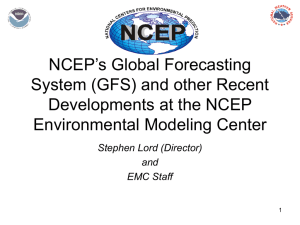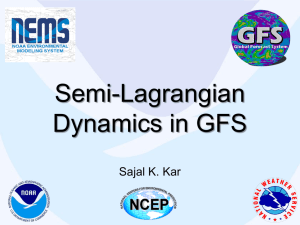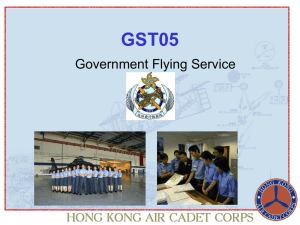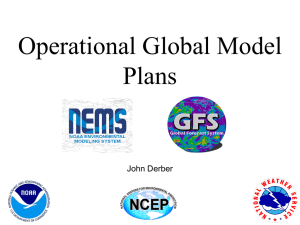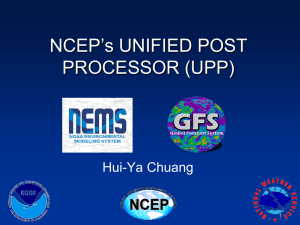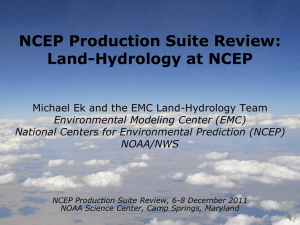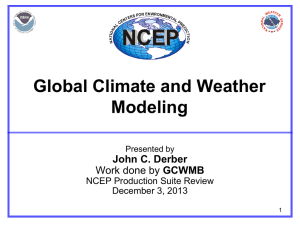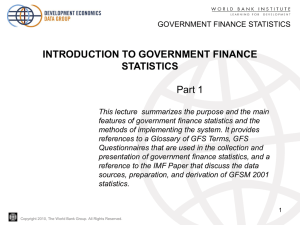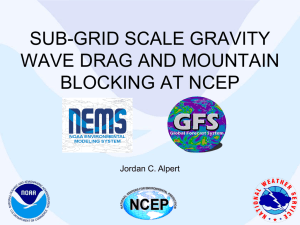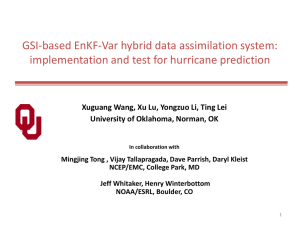PPT
advertisement
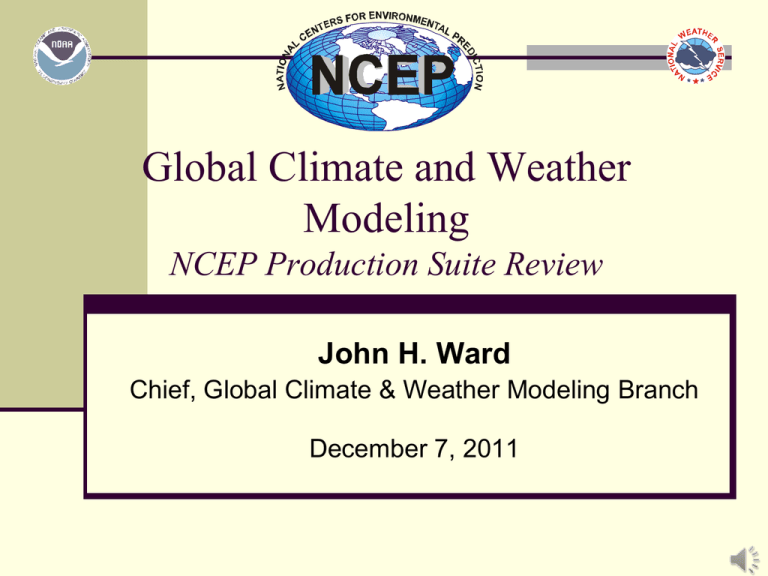
Global Climate and Weather Modeling NCEP Production Suite Review John H. Ward Chief, Global Climate & Weather Modeling Branch December 7, 2011 Outline Personnel FY11 Upgrades FY12 and Beyond Global Model Roadmap 2 Personnel Global Modeling Modeling Team Lead S. Moorthi Glenn White Jordan Alpert Mike Young Yutai Hou Huiya Chuang DaNa Carlis Henry Juang Diane Stokes Mark Rozwodoski Qingfu Liu Suru Saha Fanglin Yang Sajal Kar Yali Ma Kate Howard Jia-Fong Fan Feds - Blue Climate Modeling Climate Team Lead Dave Behringer Xingren Wu Ensembles Infrastructure Mark Iredell – Lead Edward Colon Ratko Vasic Dusan Jovic Dmitry Sheinin Weiyu Yang Jun Wang Nicole McKee Patrick Tripp Eugene Mirvis Visiting Scientists – Red Yuejian Zhu – Lead Dinchen Hou Jun Du Richard Wobus Bo Cui M. Pena-Mendez Jesse Ma Jiayi Peng Yan Lou Bo Yang Physics Hualu Pan Jongil Han Ruiyu Sun 3 Contractor - Black Personnel Data Assimilation Feds - Blue John Derber – Lead Russ Treadon Daryl Kleist George Gayno Andrew Collard David Groff Greg Krasowski Xu Li Haixa Liu Shun Liu Mike Lueken Michiko Masutani Dave Parrish Jim Purser Miodrag Rancic Xiujuan Su MingJing Tong Paul Van Delst Wan-Shu Wu Yanqiu Zhu Fedor Mesinger Lidia Cucurull - Boulder Visiting Scientists – Red Land Surface Mike Ek – Lead Jiarui Dong Jesse Meng Helin Wei Vince Wong Yihua Wu Youlong Xia Ringqian Yang Weizhong Zheng 4 Contractor - Black Personnel Dynamics S. Moorthi Henry Juang Sajal Kar Jia-Fong Fan Mike Young Jordan Alpert Ocean/SST Dave Behringer Diane Stokes Ensembles Programming/User Support Kate Howard Mark Rozwodoski Post Processing/Product Huiya Chuang DaNa Carlis Yali Ma Climate Modeling Xingren Wu Tropical Storms Qingfu Liu Infrastructure Radiation/Physics Yutai Hou Hualu Pan Jongil Han Ruiyu Sun Suru Saha Diagnostics/Verification Glenn White Fanglin Yang Yuejian Zhu Dinchen Hou Jun Du Richard Wobus Bo Cui M. Pena-Mendez Jesse Ma Jiayi Peng Yan Lou Bo Yang Mark Iredell Edward Colon Ratko Vasic Dusan Jovic Dmitry Sheinin Weiyu Yang Jun Wang Nicole McKee Patrick Tripp Eugene Mirvis 5 FY11 Changes NAEFS: Downscaling for Alaska – 12/7/2010 NAEFS: Inclusion of FNMOC Ens – 3/1/2011 CFSv2.0.0 – 3/30/2011 CFSv1 will continue to be run until further notice WAFS: Blended US/UK products Parallel for evaluation – 1/25/2011 Initially evaluation complete Changes implemented based on feedback – 6/15/2011 6 FY11 Changes GDAS/GFS Bundle – 5/9/2011 Improvement in 10m winds in Southwest U.S. has resulted in unrealistic GFS MOS winds MDL is testing a fix – no implementation date as yet 7 FY12 & Beyond NAEFS: GEFS Upgrade – 2QFY12 Global Aerosol System (GOCART) – 2QFY12 Hybrid EnKF-3DVar GSI Data Assimilation – 3QFY12 GFS Resolution Increase – 1QFY13 Transition to NEMS – 3QFY13 8 Global Modeling Roadmap 9 Basic Strategy All candidate models will be ported to the NOAA R&D system at Fairmont Site-B Operational GDAS & GFS will be ported to the NOAA R&D system It will become the baseline for all tests The baseline version will evolve as the operational GDAS & GFS are upgraded Models will eventually be transitioned into the NEMS framework 10 Basic Strategy Establish verification package Combined UKMET, ECMWF analysis will be used for verification If all forecast hours and/or variables are not available to verify a full 16-day forecast, the verification may need to be augmented with analyses from one or more of the candidate models. Current NCEP verification package will be used, with some modifications Options to verify a single forecast starting at a specific initial time rather than forecasts valid at a specific time Guarantee a homogeneous set of dates for all models being evaluated – missing dates from one model will be eliminated for all models Include near surface, sensible weather elements into routine package Both Grid-to-Grid and Fit-to-obs will be verified Develop a UKMET-like index to aid in determining the overall impact of proposed models Specific variables and weights will be determined prior to any model testing 11 Basic Strategy Candidate Models GFS NMMB FIM Cubed-Sphere MPAS Model configuration Each modeling may have one or more configurations with various physics, dynamic, radiation, resolution, etc. All models will output pressure GRIB files on a standard lat-lon grid Limiting factor is the operational resource window (CPU x Wallclock) Since codes may not scale the same on different architectures, they must be ported to the operational system to ensure each configuration will fit within the operational resource window 12 Basic Strategy Model configurations will be tested as members of a multi- model ensemble Two Step Process Test at full resolution against the operational GFS Configurations that perform within a given delta of the GFS will then be considered for an ensemble member at lower resolution Evaluation of value-added to the ensemble will be determined using the techniques developed for NAEFS Configurations which add value will be implemented into an operational multi-model ensemble, replacing the current GFS-based GEFS Until the 2014/15 time frame, when the Operational CCS is expected to have its next resource increase, the total number of ensemble members will remain 20 and the model resolution of each member will be similar to the then 13 Operational GEFS. Basic Strategy All members of an Operational Multi-model Ensemble must be run on the NOAA Operational computer system Ensures all members will be available to produce ensemble products NAEFS does produce Ensemble Products from members provided by CMC & FNMOC, but all of those are supported operationally by their Center Test or experimental products can be produced from Site-B runs or from members provided from other systems, but those should never be disseminated via Operational channels. 14 Basic Strategy Specific model configurations from the ensemble membership will then be tested for use as the Operational deterministic model, which will support Weather, Climate, and Data Assimilation This is the opposite of current NCEP Operations, where the ensemble system is usually the n-1 deterministic model at lower resolution With a multi-model ensemble, however, the n-l paradigm isn’t possible 15 Next Steps Infrastructure Code developers at each of the NOAA development sites need easy access (on-site) to program analyst support for each of the NOAA R&D system architectures A centralized group needs to be established to maintain common libraries and utilities at all NOAA R&D sites A centralized group needs to be established to maintain data flow between the NOAA operational and R&D sites The lack of development resources at NCEP will require both retrospective and near real-time runs at the NOAA R&D sites Subversion repository will be established to hold all candidate codes 16 Next Steps Begin comparison of NNMB & FIM with current Operational GFS Routine FIM runs from ESRL are being verified with the standard NCEP verification package 10 days only Initial results look very promising NMMB with GFS physics in NEMS are running routinely for 00Z 6 days only Need to begin verifications 17 Questions 18 NAEFS: Downscaling for Alaska Statistical Down-Scaling Techniques for Alaska ♦ Variable: surface pressure, 2-m temperature, 10-meter wind component ♦ Variable: Tmax and Tmin ♦ work well using current operational technique for CONUS Using latest define Tmax and Tmin defined period for Alaska Variable: wind speed and direction Using equal weight for wind direction distribution Possible future improvement for wind direction Alaska Verification ♦ ♦ Stats for Tmax, Tmin, wind direction/speed First a few key points: Statistical down-scaling data adds value Bias correction alone is of value Bias correction with downscaling adds significant value to the forecasts NAEFS is better than lone GEFS More members are better Present (latest) to HPC (Alaska desk) Dec. 7th 2009 19 Statistical downscaling for NAEFS forecast Proxy for truth RTMA at 5km resolution Variables (surface pressure, 2-m temperature, and 10-meter wind) Downscaling vector Interpolate GDAS analysis to 6km resolution Compare difference between interpolated GDAS and RTMA Apply decaying weight to accumulate this difference – downscaling vector Downscaled forecast Interpolate bias corrected 1*1 degree NAEFS to 5km resolution Add the downscaling vector to interpolated NAEFS forecast Application Ensemble mean, mode, 10%, 50%(median) and 90% forecasts 20 Back 21 NAEFS: Current Configuration NCEP CMC Model GFS GEM Initial uncertainty ETR EnKF Model uncertainty Stochastic Yes (STTP) Yes (multi-physics) Tropical storm Relocation None Daily frequency 00,06,12 and 18UTC 00 and 12UTC Resolution T190L28 ~70km 1.0 degree Control Yes Yes Ensemble members 20 for each cycle 20 for each cycle Forecast length 16 days (384 hours) 16 days (384 hours) Post-process Bias correction for ensemble mean Bias correction for each member Last implementation February 23rd 2010 July 10th 2007 22 NAEFS: NUOPC IOC NCEP CMC FNMOC Model GFS GEM Global Spectrum Initial uncertainty ETR EnKF Banded ET Model uncertainty Stochastic Yes (STTP) Yes (multi-physics) None Tropical storm Relocation None None Daily frequency 00,06,12 and 18UTC 00 and 12UTC 00 and 12UTC Resolution T190L28 ~70km 1.0 degree T119L30 ~1.0degree Control Yes Yes Yes Ensemble members 20 for each cycle 20 for each cycle 20 for each cycle Forecast length 16 days (384 hours) 16 days (384 hours) 16 days (384 hours) Post-process Bias correction for ensemble mean Bias correction for each member Bias correction for member mean Last implementation February 23rd 2010 July 10th 2007 May 2010 Back 23 CFS2.0.0 Forecast component frozen (T126L64) Assimilation component can evolve with GFS and GSI Current CFS Data Assimilation is fully coupled version of T574 GFS/GSI Will not change when the Hybrid data assimilation is implemented Back 24 WAFS Harmonization of UKMET and US WAFS products UKMET & US utilize different forecast models and different algorithms to produce WAFS products (Turbulence, Cb, Icing) Produces inconsistencies between the products from both Centers UKMET & US have agreed to move toward consistent algorithms to reduce differences Both Centers are testing blended products Mean products are averages of Center’s products Maximum products are values from either Center Back 25 GSI/GFS Bundle Analysis Changes Improved OMI QC Removal of redundant SBUV/2 total ozone Retune SBUV/2 ozone ob errors Relax AMSU-A Channel 5 QC New version of CRTM 2.0.2 Inclusion of Field of View Size/Shape/Power for Radiative transfer Remove down weighting of collocated radiances Limit moisture >= 1.e-10 in each outer iteration and at end of analysis Inclusion of uniform (higher resolution) thinning for satellite radiances Improve location of Buoys in vertical (move from 20 to 10m) Improved GSI code with optimization and additional options Recomputed background errors Inclusion of SBUV from NOAA-19 Ambiguous vector quality control for ASCAT (type 290) data Model Changes New Thermal Roughness Length Set minimum moisture Value in Stratosphere to Reduce background diffusion in the Stratosphere 26 Wind Speed Bias 27 Wind Speed Bias 28 Temperature Bias 29 500 MB Anomaly Correlation Northern Hemisphere Southern Hemisphere 30 Precipitation Back 31 NAEFS: GEFS Upgrade Major Improvements Resolution Increase T190L28 T254L42 (0 - 192 hrs) T190L28 T190L42 (192 - 384 hrs) Improved initial perturbations Improved stochastic total tendency perturbations Product Delivery Delays Raw GFS GRIB data will be delayed ~20 minutes Delays will gradually increase with forecast length Bias corrected GRIB will be delayed ~ 20 minutes Probabilistic Products will be ON TIME 32 FCST +4:35 --- +5:15 Current FCST +4:35 --- +5:35 NO IMPACT ON NAEFS FNMOC_ENS_DEBIAS +7:20 --- +7:30 20m late finish NCEP_POST +4:37 --- +5:17 Future NAEFS products start NCEP_POST (PGB) +4:37 --- +5:37 Delays grow to 20 minutes at 16 days +5:00 +6:00 +7:35 +7:00 +9:00 CMC_ENS_PREP CMC_ENS_POST +7:20 --- +7:22 ENS_DEBIAS +4:40 --- +5:24 ENS_DEBIAS +5:00 --- +5:44 CMC_ENS_DEBIAS +7:22 --- +7:26 PROB_PRODUCTS +5:24 --- +6:45 20m late start +8:00 NAEFS_PROB_PROD (1) +7:33 -- +8:08 PROB_PRODUCTS +5:44 --- +6:40 5m early finish GEFS/NAEFS 6-hr window flow chart NAEFS products (2) +8:08 --- +9:08 Back 33 GSI Hybrid EnKF-3DVAR Upgrade Possible components (NSST and Combination with CDAS removed) GPS RO bending angle rather than refractivity Inclusion of compressibility factors for atmosphere Retune SBUV ob errors – fix bug at top Update radiance usage flags Prepare for monitoring NPP and Metop-B Add GOES-13 data Add Severi CSBT radiance product Satellite monitoring stats code included in Ops. New Sat wind data and QC EnKF hybrid system – modify inflation factors Update to current version of trunk New version of Forecast model Restructured to include options for Semi-Lagrangian & NSST Model, and corrected a bug in lake elevation. Updated postprocessor CAPE, CIN, & Lifted Index calculated from virtual temperature Ability to output GRIB2 directly 10 new variables for Fire Wx & 6 for Wind Energy Back 34 NRT NGAC configuration Experimental (non-operational) 120-hr dust-only forecast once per day (00Z) ICs: Aerosols from previous day forecast and meteorology from operational GDAS 3-hourly products: 3d distribution of dust aerosols (5 bins from 0.1 – 10 µm) Automatic output archive, post-processing and web update since June 11, 2011 Same physics and dynamics as operational GFS with the following exceptions: Lower resolution (T126 L64) Use Relaxed Arakawa-Schubert scheme [Moorthi and Suarez, 1999] with convective transport and tracer scavenging Aerosol-radiation feedback turned off 35 Sample Forecast Back 36 GFS 1QFY13 Upgrade T1178L64 Semi-Lagrangian Resource Nuetral Back 37 FIM purpose and configurations Purpose: A next-generation global model for NOAA (candidate for NCEP ops, coupled model research) Resolution Real-time testing at 60km, 30km, 15km resolution icosahedral horizontal grid 64 vertical levels – hybrid θ-σ Ptop = 0.5 hPa, -top = 2200K Physics Currently GFS physics suite (2010 version) Initial conditions •GFS/GSI spectral data to FIM icos hybrid θ-σ vertical coordinate •Ensemble Kalman using GFS T254 – Jeff Whitaker, ESRL Application at NCEP Likely application in GEFS, candidate for future global model 38 Versions of FIM running – Fall 2011 Resolution Init conds Physics Stream 1.5 30km GSI GFS (July 2010) No 30km EnKF GFS Yes FIM9 FIMX 15km EnKF GFS No 60km GSI/cyc GFS + WRF-chem, chem testing of Grell cu No FIM7 60km GSI GFS No FIMens 60km, 10mem EnKF GFS No FIMens 27km, 4mem EnKF GFS No FIM FIMY - Stream 1.5 39 FIM Development at NCEP Strong progress toward NCEP operational status Preliminary tests of FIM done on NCEP CCS MOA with NCEP to run FIM as part of Global Ensemble Forecast System (GEFS) under NEMS. GSD’s Advanced Computing Group worked closely with NEMS developers at NCEP to work out basic NEMS design issues as well as to get FIM under NEMS Testing of FIM to start within NEMS GEFS framework at NCEP in next few months NCEP doing their own verification now of FIM 38-level version of FIM tested – equal performance with L64 – readiness for GEFS. (Fewer levels should fare well with isentropic-hybrid coordinate …. and apparently do) 40 HFIP Global Model/Physics Team plans for FY12 FIM - Testing in GEFS under NEMS Model enhancements toward efficiency Testing of WRF physics (Grell cumulus), other physics Critical for improving tropical cyclone diversity Physics – diversity between GFS and FIM should improve multi-model TC ensemble Grell 3-d convective scheme – now in testing FIM-chem with more complex microphysics (2-moment cloud at least) for coupling with aerosol (Saharan dust, sea salt, etc.) – Georg Grell Stochastic physics, other devices to increase ensemble diversity – Jian-Wen Bao, Georg Continued development of CFIM (coupled atmosphere-ocean FIM with icos HYCOM) Use of long runs for evaluation of FIM TC climate and diagnosis of physics problems Continue work toward FIM-based EnKF-hybrid (Phil Pegion, Jeff W) 41 7-day 500 hPa anomaly correlation 1 Aug – 31 Dec 2010, 135 cases N. Hemis S. Hemis Arctic Antarctic 20-80N 20-80S 70-90N 70-90S New version of FIM – Nov 2011 73.46 65.66 66.66 46.97 GFSDC 72.90 65.20 65.49 44.46 Verification against GFS analyses, GFS used for initial conditions NOTE: FIM physics matches that used for GFS in fall 2010, not using the May11 GFS physics modifications Back 42 NMM-B Dynamical Core Nonhydrostatic Multiscale Model on B grid (NMM-B) (Janjic, 2005; Janjic and Black, 2007) Further evolution of WRF NMM (Nonhydrostatic Mesoscale Model) Intended for wide range of spatial and temporal scales, from meso to global, and from weather to climate Evolutionary approach, built on NWP and regional climate study experience by relaxing hydrostatic approximation (instead of extending cloud models to large scales; Janjic et al., 2001, MWR; Janjic, 2003, MAP) The nonhydrostatic option as an add–on nonhydrostatic module Applicability of the model extended to nonhydrostatic motions Favorable features of the hydrostatic formulation preserved Reduced cost at lower resolutions Easy comparison of hydrostatic and nonhydrostatic solutions Pressure based vertical coordinate Nondivergent flow on coordinate surfaces (often forgotten) No problems with weak static stability on meso scales 43 Zavisa Janjic Global NMMB ~1 year 500 hPa Height Anomaly Correlation Coefficient vs forecast time NMMB initialized and verified using GFS analyses Global North Hemisphere South Hemisphere Tropics 44 Zavisa Janjic Back
